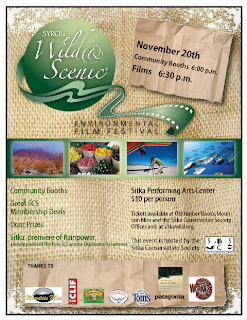Explain
This unit was a good one for me, mostly because I have never seen true sea ice. Here in Southeast, we simply don't have any sea ice to speak of, so the whole idea of a large body of frozen water is pretty fascinating and seems impossible. Likewise the idea of being affected here by a change in this sea ice that I have never seen before is a new concept.
I was interested to learn about the ICC Canada and the summit to deal with these sea ice changes. It was good to see that people from all over the world come togather and discuss the things that they have in common and work toward a common goal. Here in Sitka we have the Sitka Conservation Society and their members bring in speakers and have forum discussions about topics of interest around the Tongass National Forest. Below is a poster for their latest local film festival.
Extend:
How will I use this new information? Well, first I need to make it relevant - which will be easy to do since we live on an island in Southeast and sea is a very large concern. If we had working computers here I would play the TD video about Shishmaref and point out that it is also a village along a coastline, just like us.
I loved the lab about watching ice melt and seeing the change in volume. I will probably use that when I teach states of matter later on this year. I point out that water, with its unique bonds, is the only substance in the world that's solid is less dense than it's liquid state. To illustrate that, we also take wax and add heat and watch it go through the state changes. In both cases when you add a piece of solid wax to the liquid wax, it sinks like a rock.
I will also try and explain the positive feedback system to my students but I will most likely use a different example, one that they can more easily visualize. - I like the idea of a snowball rolling down a hill: the bigger it gets, the heavier and the faster it goes and the bigger it gets...
Evaluate
How is this relevant? Well, as a resident of a coastal Alaskan village, any change in the sea directly affects us. However, the challenge is to illustrate that to my kids, none of which have ever seen any signigicant sea ice. I like the NASA Sea Ice interaction to illustrate just how much change has occured in such a short period of time. As I teach it to my students, the earth's systems are all in balance with each other like two kids on a teeter-totter - as things change slowly over time, the different systems adapt to adjust for it, the same way the kids balance each other. Any change that is to major or to fast, and somone falls off and then the whole system crashes. The Polar Ice caps are just another one of those systems that we need to keep in balance...
3C's
I visited Martha who had a really neat picture of Prince William Sound.
I visited Sabrina at Sabrina Sutton's Excited about Alaska who had an interesting point of view about Microbes and how cliamte change affects their ability to break down matter.
I visited Chena Lakes Farm and was interested in what is happing up at Fairbanks since I left. This is expecially interesting to me since I have spent a long time there and still have family up there.


I love how each person's blog focuses on different aspects of the topic. The positive feedback loop concept is a challenge for kids ... good luck!
ReplyDeleteGood idea using wax in the ice melt lab as a comparison.
ReplyDeleteTyler, water is not the only substance that is less dense as a solid than a liquid. Bismuth, Gallium, Germanium, and Silicon are all less dense in their solid forms. Interestingly, they are all elements. I am sure that someone could make/find some compounds (besides H20)that also have this neat characteristic. Nice blog entry.
ReplyDelete